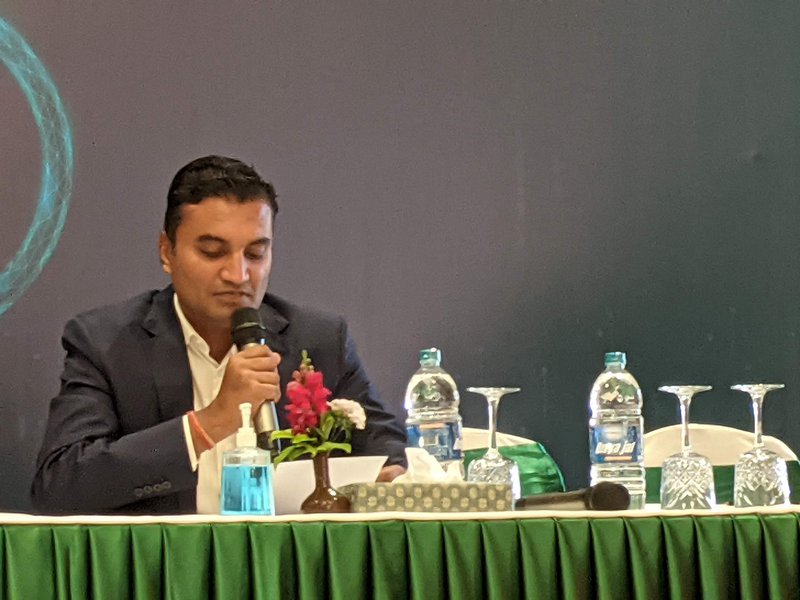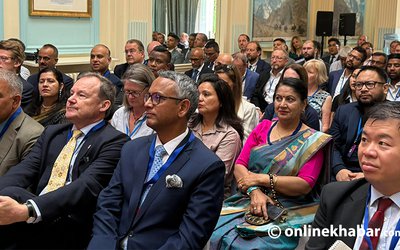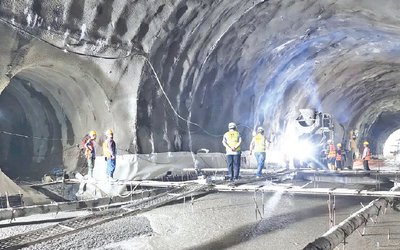
A total of 800 individuals, including 300 foreigners, have confirmed their attendance at the next Eight Power Summit 2023, according to Krishna Prasad Acharya, president of the Independent Power Producers Association (IPPAN).
The Eighth Power Summit 2023 will be held here from April 18 to 19 with the theme "Broadening Green Energy Market" will be hosted by the Independent Power Producers' Association (IPPAN).
He said that among the participants are senior members of the Ministry of Energy, Water Resources, and Irrigation, as well as representatives from financial institutions, transmission and distribution businesses, consulting firms, suppliers, and think tanks.
President Acharya said that the main objective of the summit is to pave the way for identifying and opening doors for Nepal's green energy market and at same time to strengthen commercial and business ties, sign many agreements for the development and market creation of electric energy, and will provide an opportunity to trade energy.In the summit, various sessions will be held covering Nepal's electricity market, transmission infrastructure.
India, Bhutan, Bangladesh, and Sri Lanka will all send high-level delegations to the summit, according to President Acharya.
“Hydropower demand in Nepal, technological advancements, solar energy, hydrogen, regulatory agencies, global electricity commerce, and environmentally responsible growth,” said Acharya.
The upcoming power summit, according to IPPAN vice president Ashish Garg, would be of utmost importance given the rising need for sustainable energy both domestically and abroad. He claimed that the private sector's interest in India is encouraging.
Secretary Dinesh Kumar Ghimire and Managing Director of Nepal Electricity Authority Kul Man Ghising delivered video message highlighting the importance of summit for Nepal’s energy sector development.
On behalf of the Nepal Investment Board and the commercial sector, 5,000 megawatt projects (Project Bank) will be displayed in the meantime on topics relating to energy security, regional collaboration, and social and ethical challenges. Investors who want to invest in the energy business will have a rare opportunity to learn about energy projects.
The Summit will be opened by the Prime Minister of Nepal in the presence of dignitaries from the Ministry of Energy, Water Resources and Irrigation and South Asian Leaders. It has been organized by IPPAN with the support of the Office of Investment Board, Nepal, and the patronage of the Ministry of Energy, Water Resources and Irrigation, Government of Nepal.

The organizer claims that the Indian Embassy in Kathmandu would serve as the country partner and will be represented by a sizable Indian delegation. The World Bank, IFC, FMO, USAID, power trading firms, power producers, financial institutions, transmission and distribution firms, consulting firms, vendors, think tanks, and other power sector stakeholders are among the summit's principal sponsors, according to vice president Gerg.
The energy industry has advanced significantly since we held the first Power Summit in 2006. Now that it generates its own electricity, Nepal is moving closer to being an energy-surplus country. The installed capacity has increased to 2520MW with the recent integration of the 86MW Solu Dudhkoshi Hydropower Project into the national grid. By 2023, a further 600MW of capacity will be added, bringing the total up to 6700MW by 2027. From the current 55%, the private sector participation is anticipated to increase to 80% of installed capacity.
“Since we hosted the first Power Summit in 2006, the energy industry has advanced significantly. Now that it generates its own electricity, Nepal is moving closer to being an energy-surplus country. The installed capacity has increased to 2520MW with the recent integration of the 86MW Solu Dudhkoshi Hydropower Project into the national grid. By 2023, a further 600MW of capacity will be added, bringing the total up to 6700MW by 2027. From the current 55%, the private sector participation is anticipated to increase to 80% of installed capacity,” said Acharya.
Although Nepal lacks coal and other fossil fuels, it possesses a wealth of renewable energy sources, such as sun, wind, biomass, and hydropower. The supply side of Nepal's green energy has significantly improved over the last ten years, and it is now time to concentrate on the demand side. Now is the time to "broaden green energy markets," first domestically and then regionally. Sometimes, the study of economics can be reduced to a study of demand and supply. Frequently, the demand side will be the one to offer the necessary incentives for a high-quality supply. How we handle the supply side of green energy will be determined by demand.
Losses and wastage result from investments made without a thorough understanding of the demand side. If we had a better understanding of the green energy market and the nature of demand, we could, for instance, manage which plants should generate power and at what time of day. Forecasts of demand aid in setting the pace for supply-side investment in a cash-strapped economy. We need to have this discussion right away since we are prepared to launch our green energy on the market.
To expand the use of green energy, it is necessary to make it possible for sectors like commerce, transportation, agriculture, manufacturing, and cooking to both develop quickly and fully transition to using green energy instead of the expensive fossil fuels that Nepal must import. Young people labor in fossil fuel-producing nations and send money home as remittances, which we use to purchase fuel from those same nations. This downward spiral can and must be stopped. The time is opportune to expand the market for green energy because of this.
Nepal has been identified as one of the most susceptible countries as a result of the effects of climate change. The entire globe is already feeling the effects and rising costs of extra greenhouse gases in the atmosphere. Nepal has pledged to achieve a net zero country by 2045. A key part of that is being able to generate and consume green energy while also removing fossil fuels from our economy.
The Summit will feature thirteen sessions on topics such as Nepalese power markets, transmission infrastructure, hydropower demand in Nepal, technology and innovation, thinking beyond hydropower to solar and hydrogen, regulatory framework, cross-border power trade, sustainable and climate-resilient development, environment, social and governance, regional interests, and energy security. Projects of 5000 MW will be displayed from the IBN Project Bank and the private sector. The investors will have a one-of-a-kind opportunity to debate and comprehend power project investments. During the Summit, workshops and side events such as the CEO Forum and ESG practices will be organized..
“We hope to create a forum for discussion, discourse, and debate among all relevant specialists in the power industry, and this event is not to be missed by anybody interested in participating in Nepal's power development journey. Many agreements and understandings for future development and market formation are also scheduled to be signed at the Summit. “We welcome all parties involved to use this platform to conduct business and assist Nepal in moving forward with its green energy development agenda,” said Acharaya.
- Nepal-UK Tech Forum Held
- Jul 06, 2025
- Hari Sayani or Devshayani Ekadashi 2025: Day Of Tulsi Plantation
- Jul 06, 2025
- Siddhababa Tunnel Makes A Major Milestone
- Jul 06, 2025
- Weather Forecast: Generally Cloudy Across The Country With Heavy Rain At One Or Two Places Gandaki, Bagmati and Koshi Provinces
- Jul 06, 2025
- India’s External Affairs Ministry’s Senior Officials Says Indo-Nepal relations are ever expanding
- Jul 05, 2025















